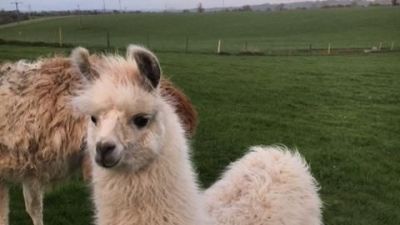Llama Keeper Experience in Hampshire – Meet Piper at Hensting Alpacas
Spend the morning learning how to care for our friendly llama Piper in this hands-on family experience at Itchen Valley Country Park.
Llama Keeper Experience at Hensting Alpacas
New for 2024 — become a Llama Keeper for the day at Hensting Alpacas, now based at Itchen Valley Country Park in Hampshire. Meet Piper, our friendly young llama, and join our team for a hands-on, behind-the-scenes experience that’s perfect for kids and families.
What’s Included in the Llama Keeper Experience?
This exclusive morning experience gives you and your child the chance to work one-on-one with a dedicated member of our staff. You'll get to:
- Start your morning at 9:00 AM with an introduction to your guide
- Help feed the alpacas and Piper the llama
- Lay out hay and learn to care for our herd (15 minutes of light mucking out included)
- Take Piper for a relaxing, gentle walk around the grounds
- Learn fun facts about llamas, alpacas, and their South American heritage
- Snap photos for social media and our team’s gallery
- Enjoy a short break (bring a snack or picnic)
- Visit the shop before heading home around 12:15 PM
Important: One child must be accompanied by one adult (1 ticket = 1 child + 1 adult). Children cannot attend unaccompanied or be left with our staff.
Pricing & Times
- Experience Time: 09:00 AM – 12:15 PM
- Gates Close: 08:55 AM (no late entry allowed)
- Price: £80 per ticket (includes 1 child + 1 adult)
- No reschedules or cancellations after booking
Location & Parking
All experiences take place at:
Hensting Alpacas
Itchen Valley Country Park, Allington Lane, West End, Southampton, SO30 3HQ
- Parking: £3.30 (short stay) or £5.30 (full day)
- Look for the Alpaca sign near the first car park on arrival
- What3Words: ///worker.dangerously.worked
Wellington boots are available to hire during muddy conditions.
Fun Llama Facts
- Llamas are members of the camelid family, related to alpacas, vicuñas, and guanacos
- Domesticated in Peru over 6,000 years ago, they were used for transport, wool, and meat
- They can weigh up to 300 lbs and live around 25–30 years
- Female llamas usually give birth standing up — their babies are called "crias"
- Llamas don’t follow heat cycles and can breed year-round
- They hum to communicate, and while they can spit, it’s usually reserved for other llamas
- Llamas are intelligent and can learn commands — some are used for therapy or as livestock guards
Llamas vs Alpacas
Do I Eat It or Wear It?
In Peru and across South America, llamas are often raised as pack animals and for meat. Alpacas, by contrast, are prized for their ultra-soft fleece. Here’s how to tell them apart:
- Size: Llamas are larger and stronger
- Fleece: Alpaca fleece is finer and softer than llama wool
- Ears: Llamas have banana-shaped ears; alpacas have short, straight ears
- Temperament: Both are gentle, but llamas are more independent
Llamas are descended from guanacos, while alpacas evolved from vicuñas. Both were domesticated by ancient South American cultures and remain central to agriculture in Peru, Bolivia, and Chile.
Memories That Last
During your experience, we encourage you to take photos — Piper is very photogenic! We also love posting to social media, so your llama adventure may be shared with our online followers.
Many families return year after year to see how Piper’s grown and to meet new additions to the herd.




